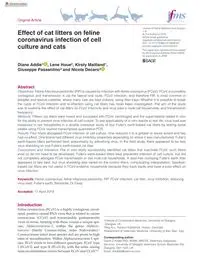
2019 Effect of cat litters on feline coronavirus infection of cell culture and cats PDF
Preview 2019 Effect of cat litters on feline coronavirus infection of cell culture and cats
https://doi.org/10.1177/1098612X19848167 Journal of Feline Medicine and Surgery 1 –8 © The Author(s) 2019 Article reuse guidelines: sagepub.com/journals-permissions DOI: 10.1177/1098612X19848167 journals.sagepub.com/home/jfm This paper was handled and processed by the European Editorial Office (ISFM) for publication in JFMS Introduction Feline coronavirus (FCoV) is a highly contagious, envel- oped, positive-strand RNA virus that is related to canine coronavirus (CCoV) and transmissible gastroenteritis virus of swine, forming with these viruses a unique spe- cies, Alphacoronavirus-1, within the genus Alphacor- onavirus (family Coronaviridae, order Nidovirales).1 Coronaviruses infect most species and are prone to high rates of recombination. Within Alphacoronavirus-1 spe- cies, FCoV exists in two different genotypes, FCoV type I (FCoV-I) and type II (FCoV-II), with the latter arising from recombination events between FCoV and CCoV.2,3 Effect of cat litters on feline coronavirus infection of cell culture and cats Diane Addie1 , Lene Houe2, Kirsty Maitland1, Giuseppe Passantino3 and Nicola Decaro3 Abstract Objectives Feline infectious peritonitis (FIP) is caused by infection with feline coronavirus (FCoV). FCoV is incredibly contagious and transmission is via the faecal–oral route. FCoV infection, and therefore FIP, is most common in breeder and rescue catteries, where many cats are kept indoors, using litter trays. Whether it is possible to break the cycle of FCoV infection and re-infection using cat litters has never been investigated. The aim of the study was to examine the effect of cat litters on FCoV infectivity and virus load in multi-cat households, and transmission frequency. Methods Fifteen cat litters were mixed and incubated with FCoV, centrifuged and the supernatants tested in vitro for the ability to prevent virus infection of cell culture. To test applicability of in vitro results to real life, virus load was measured in two households in a double crossover study of four Fuller’s earth-based cat litters by testing rectal swabs using FCoV reverse transcriptase quantitative PCR. Results Four litters abrogated FCoV infection of cell culture, nine reduced it to a greater or lesser extent and two had no effect. One brand had different virus inhibitory properties depending on where it was manufactured. Fuller’s earth-based litters performed best, presumably by adsorbing virus. In the field study, there appeared to be less virus shedding on one Fuller’s earth-based cat litter. Conclusions and relevance The in vitro study successfully identified cat litters that inactivate FCoV; such litters exist so do not need to be developed. Fuller’s earth-based litters best prevented infection of cell culture, but did not completely abrogate FCoV transmission in two multi-cat households. A dust-free clumping Fuller’s earth litter appeared to fare best, but virus shedding also varied on the control litters, complicating interpretation. Sawdust- based cat litters are not useful in FCoV-endemic households because they track badly and have a poor effect on virus infection. Keywords: Feline coronavirus; feline infectious peritonitis; FIP; FCoV infection; cat litter; virus inhibition; reducing virus load; Fuller’s earth; Bentonite; Dr Elsey Accepted: 11 April 2019 1 Institute of Comparative Medicine, University of Glasgow, Glasgow, UK 2Reg Acc, Felismir Katteklinik, Hvalso, Denmark 3Department of Veterinary Medicine, University of Bari, Bari, Italy Corresponding author: Diane D Addie PhD, BVMS, MRCVS, Veterinary Diagnostic Services, University of Glasgow Veterinary School, Bearsden Rd, Glasgow, G61 1QH, UK. Email:
